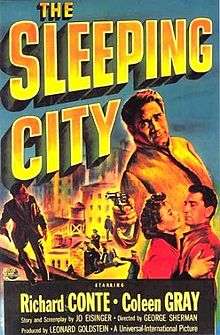The Sleeping City
| The Sleeping City | |
|---|---|
 Theatrical release poster | |
| Directed by | George Sherman |
| Produced by | Leonard Goldstein |
| Screenplay by | Jo Eisinger |
| Story by | Jo Eisinger |
| Starring |
Richard Conte Coleen Gray |
| Narrated by | Richard Conte |
| Music by | Frank Skinner |
| Cinematography | William Miller |
| Edited by | Frank Gross |
Production company |
Universal International |
| Distributed by | Universal International |
Release dates |
|
Running time | 85 minutes |
| Country | United States |
| Language | English |
The Sleeping City is a 1950 film noir crime film in semidocumentary style, that was set in and shot at New York's Bellevue Hospital. It was directed by George Sherman starring Richard Conte and Coleen Gray.[1]
The film is notable for its dark and evocative photography, above-par performances by featured players and taut script by Jo Eisinger, best known for his script of Night and the City. It was one of the few motion pictures of the era to be shot entirely on location.
The Sleeping City is viewed by critics as one of the best examples of the use of betrayal—in this instance, several layers of betrayal—as a noir plot device. However, as is typical in this genre/style, the film is simply plotted and economical in its characterizations.
The movie begins with an unusual prologue, featuring Conte, to assure the audience that the story is "completely fictional" and did not take place at Bellevue or New York City. The prologue was inserted at the insistence of New York mayor William O'Dwyer, who had objected to the script as besmirching the reputation of the city-run hospital.
Plot
An intern is shot mysteriously on an East River pier adjoining Bellevue Hospital. The chief investigating detective views this as a difficult case, so with the cooperation of the Commissioner of Hospitals he assigns a detective who had been a medical corpsman, Fred Rowan of the Confidential Squad, to go undercover as intern "Fred Gilbert."
Rowan becomes involved with the attractive nurse Ann Sebastian (Coleen Gray), and also becomes friendly with the popular elevator operator, Pop Ware (Richard Taber).
Ware, who works part-time taking bets, seems initially to be a benign character. But it becomes apparent that Ware has been loaning money to the interns, including the slain intern and another intern, Rowan's roommate Steve Anderson (Alex Nicol), who is depressed and commits suicide.
Rowan deliberately loses money betting with Ware, and Ware says that Rowan can pay off his bet by stealing "white stuff"—narcotics. Rowan plays along, encouraged by Ann Sebastian. He stops providing drugs to Ware. Ware tries to kill Rowan, and is shot in a shootout on the roof of the hospital.
Investigators find that the nurse worked as a courier for Ware. The movie ends with Rowan, turning aside pleas from Ann, placing her under arrest.
Cast
- Richard Conte as Fred Rowan
- Coleen Gray as Ann Sebastian
- Richard Taber as Pop Ware
- John Alexander as Insp. Gordon
- Peggy Dow as Kathy Hall
- Alex Nicol as Dr. Steve Anderson
Reception
Critical response
Film critic Bosley Crowther dismissed the film, "New York's famous Bellevue Hospital is the literal and alluring locale for a frankly fictitious mystery drama about internes and the smuggling of dope ... But beyond this pictorial asset, which is employed mainly for atmosphere, there is little about The Sleeping City to distinguish it from any thriller film ... for all its performance and direction by George Sherman in a tensile thriller style, The Sleeping City is just a mystery-chase film with a hospital as its locale. It is not the fine cosmopolitan drama of medical practice and human life that it had every chance to be."[2]
Film critic Bruce Eder discussed the "cinéma vérité-style" crime thrillers produced in the 1950s. He wrote, "Universal made The Sleeping City as its own contribution to the cycle, directed by George Sherman. The results weren't as stylistically striking as The Naked City, but had an appeal all its own -- the location shots had a more polished and slightly more visually lyrical look than those of The Naked City, and if the music by Frank Skinner (who'd scored part of the Dassin movie) wasn't as ornate as that of Miklós Rózsa (who scored the Dassin movie's finale), it helped sustain the tension set up by the script."[3]
See also
References
- ↑ The Sleeping City at the American Film Institute Catalog.
- ↑ Crowther, Bosley. The New York Times, film review, September 21, 1950. Accessed: August 18, 2013.
- ↑ Eder, Bruce. Allmovie by Rovi, film/DVD review, no date. Accessed: August 18, 2013.
External links
- The Sleeping City at the American Film Institute Catalog
- The Sleeping City at the Internet Movie Database
- The Sleeping City at AllMovie
- The Sleeping City at the TCM Movie Database